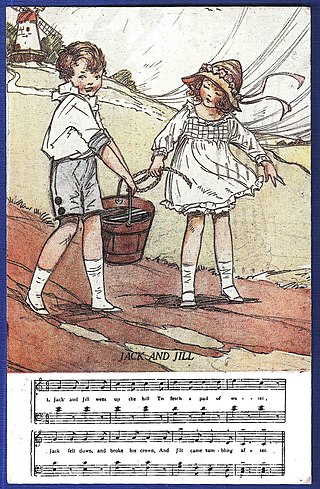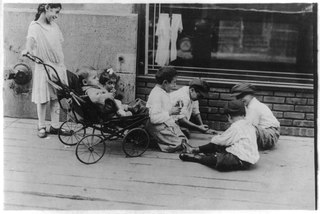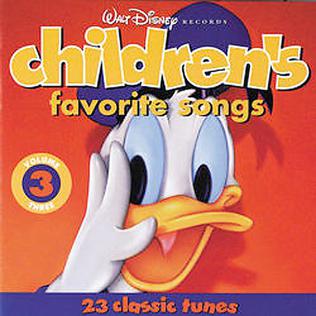
A nursery rhyme is a traditional poem or song for children in Britain and many other countries, but usage of the term dates only from the late 18th/early 19th century. The term Mother Goose rhymes is interchangeable with nursery rhymes.

The figure of Mother Goose is the imaginary author of a collection of French fairy tales and later of English nursery rhymes. As a character, she appeared in a song, the first stanza of which often functions now as a nursery rhyme. This, however, was dependent on a Christmas pantomime, a successor to which is still performed in the United Kingdom.

Jackanory is a BBC children's television series which was originally broadcast between 1965 and 1996. It was designed to stimulate an interest in reading. The show was first transmitted on 13 December 1965, and the first story was the fairy-tale "Cap-o'-Rushes" read by Lee Montague. Jackanory continued to be broadcast until 1996, with around 3,500 episodes in its 30-year run. The final story, The House at Pooh Corner by A. A. Milne, was read by Alan Bennett and broadcast on 24 March 1996. The show was briefly revived on 27 November 2006 for two one-off stories, and the format was revived as Jackanory Junior on CBeebies between 2007 and 2009.

"Jack and Jill" is a traditional English nursery rhyme. The Roud Folk Song Index classifies the commonest tune and its variations as number 10266, although it has been set to several others. The original rhyme dates back to the 18th century and different numbers of verses were later added, each with variations in the wording. Throughout the 19th century new versions of the story were written featuring different incidents. A number of theories continue to be advanced to explain the rhyme’s historical origin.

"Little Jack Horner" is a popular English nursery rhyme with the Roud Folk Song Index number 13027. First mentioned in the 18th century, it was early associated with acts of opportunism, particularly in politics. Moralists also rewrote and expanded the poem so as to counter its celebration of greediness. The name of Jack Horner also came to be applied to a completely different and older poem on a folkloric theme; and in the 19th century it was claimed that the rhyme was originally composed in satirical reference to the dishonest actions of Thomas Horner in the Tudor period.

"Baa, Baa, Black Sheep" is an English nursery rhyme, the earliest printed version of which dates from around 1744. The words have not changed very much in two and a half centuries. It is sung to a variant of the 1761 French melody Ah! vous dirai-je, maman.

Roberta Williams' Mixed-Up Mother Goose is a computer game first released by Sierra On-Line in 1987. It is, in essence, an edutainment title, directed specifically at young gamers, as well as an adventure game. It was the first multimedia game released on CD-ROM in 1991. A second game in the series, Mixed-Up Fairy Tales, was released in 1991.

Mother Goose in Prose is a collection of twenty-two children's stories based on Mother Goose nursery rhymes. It was the first children's book written by L. Frank Baum, and the first book illustrated by Maxfield Parrish. It was originally published in 1897 by Way and Williams of Chicago, and re-released by the George M. Hill Company in 1901.

Childlore is the folklore or folk culture of children and young people. It includes, for example, rhymes and games played in the school playground. The best known researchers of the field were Iona and Peter Opie.
Tommy Thumb's Pretty Song-Book is the first extant anthology of English nursery rhymes, published in London in 1744. It contains the oldest printed texts of many well-known and popular rhymes, as well as several that eventually dropped out of the canon of rhymes for children. A copy is held in the British Library. In 2013 a facsimile edition with an introduction by Andrea Immel and Brian Alderson was published by the Cotsen Occasional Press.

"Little Orphant Annie" is an 1885 poem written by James Whitcomb Riley and published by the Bowen-Merrill Company. First titled "The Elf Child", the name was changed by Riley to "Little Orphant Allie" at its third printing; however, a typesetting error during printing renamed the poem to its current form. Known as the "Hoosier poet", Riley wrote the rhymes in 19th-century Hoosier dialect. As one of his most well known poems, it served as the inspiration for the comic strip Little Orphan Annie which itself inspired a Broadway musical, several films, and many radio and television programs.

Disney's Children's Favorite Songs, Volume 3 is a collection of 23 best-loved songs for kids. The songs are performed by Larry Groce and The Disneyland Children's Sing-Along Chorus. The Choral Director is Betty Joyce. The CD is produced by Pat Patrick and Ron Kid, and engineered by Kent Madison and George Charouhas.

Mots D'Heures: Gousses, Rames: The D'Antin Manuscript, published in 1967 by Luis d'Antin van Rooten, is purportedly a collection of poems written in archaic French with learned glosses. In fact, they are English-language nursery rhymes written homophonically as a nonsensical French text ; that is, as an English-to-French homophonic translation. The result is not merely the English nursery rhyme but that nursery rhyme as it would sound if spoken in English by someone with a strong French accent. Even the manuscript's title, when spoken aloud, sounds like "Mother Goose Rhymes" with a strong French accent.

Old King Cole is a 1933 Disney cartoon in the Silly Symphonies series, based on several nursery rhymes and fairy tales, including Old King Cole. It was directed by David Hand and released on July 29, 1933.
Rub-A-Dub-Dub was a British television series animated by Peter Lang and Alan Rogers of the Cut-Out Animation Co. They were previously famous for Pigeon Street. The series was produced by David Yates and Joe Wolf. The title is a reference to the nursery rhyme Rub-a-dub-dub. Rub-A-Dub-Dub was animated in a similar way, yet all the characters were anthropomorphic animals. It ran in 1984, completing 25 episodes.
Jim Henson's Mother Goose Stories is a children's television show hosted by Mother Goose, who tells her three goslings the stories behind well-known nursery rhymes.
The Truth About Mother Goose is an animated film released on August 28, 1957, by Walt Disney Productions. The short was directed by Wolfgang Reitherman in his directorial debut, and Bill Justice, and written by Bill Peet.
Mother Goose Melodies is a 1931 Silly Symphonies animated film, directed by Burt Gillett. Two years later it was semi remade in Technicolor as Old King Cole.
Mary Ann Hoberman is an American author of over 30 children's books.
A Gander at Mother Goose is a 1940 Warner Bros. Merrie Melodies cartoon directed by Tex Avery and written by Dave Monahan. The short was released on May 25, 1940.













